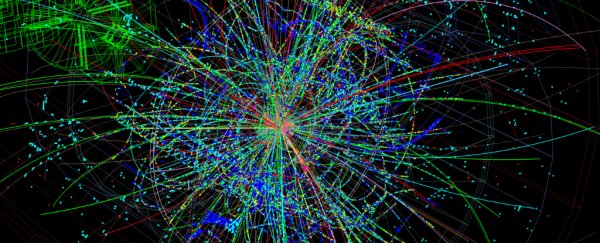The world's largest science experiment, the Large Hadron Collider (LHC), has only been around for eight years, and it's already changed our understanding of the Universe and the particles that populate it.
When the atom smasher discovered the Higgs boson back in 2012, it was a definitive moment in physics. But now the LHC is back, and more powerful than ever in its second research run, and physicists think there are even bigger discoveries in store.
The LHC works by accelerating beams of particles - usually protons - to almost the speed of light, and shoots them around its 27-kilometre-long circular tunnel that loops below Switzerland and France.
The particles are pushed along by superconducting electromagnets surrounding the metal tunnels, which are kept at –271.3 degrees Celsius - colder than outer
When the LHC is running, two particle beams travel in opposite directions along separate beam pipes - both kept in ultra-high vacuum conditions - before smashing into each other, creating such high-energy collisions that tiny, incredibly rare subatomic particles splinter into existence for a few fractions of a second before decaying.
In the LHC's first run, which lasted from 2009 to 2013, those collisions were only happening at 8 tetraelectronvolts (TeV) - which was powerful enough to provide evidence of the Higgs boson, the long-hypothesised particle that gives the Universe mass.
But, after a break of two years, the LHC officially started its second research run in April last year, with upgrades that make it capable of reaching record-breaking energies of 13 Tev.
This means the machine is now 60 percent more powerful than ever before, and has the power to teach us even more about the Universe, as well as reveal all-new particles.
So what do we have left to learn? Researchers think this latest round of research might finally reveal the particles responsible for dark matter and dark energy – the mysterious forces that make up 96 percent of the Universe.
It could also help us understand why there's so much more matter than antimatter in the Universe, and maybe even fix one of the biggest problems in modern physics – the fact that the Standard Model of Particle Physics (the best set of equations we have to understand the Universe) doesn't explain gravity.
With such high-energy collisions, researchers might even be able to uncover evidence of extra dimensions - and, yes, parallel universes - lurking just outside our reach.
"Now is a very exciting time to be a physicist," said physics professor Jon Butterworth from the University College London, about the second research run of the LHC in a public lecture last year.
This story was sponsored by the Sydney Science Festival and the Collider exhibition running at the Powerhouse Museum until October 30. Get tickets to the Collider exhibition here.
